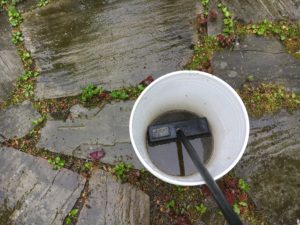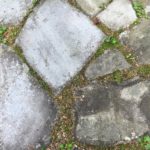Hello fellow readers,
Last week’s chat about Leaving Lichen and Moss Be brought a rally of like-minded folks (yay) such as Paulette from Wharton, who writes, “My goodness, mosses are fabulous, and lichens make wonderful art.” How true! But there can be safety concerns of slippage on walks and patios, bringing a memory of Curt’s honey-do list, including cleaning the stone patio that turned into a funny column years ago.
 Early Spring Honey-Do List
Early Spring Honey-Do List
I left the list for him and his nephew to tackle the early spring garden tasks. Advising him of things like cutting back the ornamental grasses and butterfly bush left standing for winter interest.
‘It’s okay to use your chainsaw; I know how much you love power equipment. Cut the grasses just above ground level and the butterfly bushes to about 8 inches above the ground.’
Cut Back Butterfly Bush & Ornamental Grasses
I prefer using loppers, a more serene experience, and cutting the stems at random heights. But you can’t look a gift horse in the mouth (I adore Mom’s old-time sayings). Either way cutting back butterfly bush allows them to grow to their five to six-foot floriferous selves each year rather than grow gangly and oversized.
I reminded him not to confuse the butterfly bush with the hydrangea he mowed down the year prior. The hydrangea recovered beautifully since, and Curt proudly attributes it to his unintended rejuvenation pruning.
The story ends with, ‘One more thing if you don’t mind. The stone patio has patches of algae. I know I said green is good, but I’m concerned for someone who tends to be a tad clumsy. I know you’d love to break out the power washer, but it’s tricky not to blow out the wonderful sedum and moss rooted in the nooks and crannies. Never mind the risk of damaging the stone.’
Recipes for Cleaning Stone Patios Safely
Then I provided the recipe and ingredients: ‘1/3 cup white vinegar mixed with 2/3 cup water sprayed on the algae should do the trick. After you spray, if you could scrub each stone individually (keeping away from the joints) and then hose it off, that would be great. You’re the best!’
Curt didn’t get to the one more thing that year—the gift horse grew tired (smile).
Since then, I discovered another technique and took it for a spin. Four tablespoons of baking soda (sodium bicarbonate) dissolved in a quart of warm water are safe on wood, concrete, and natural stone and won’t harm plants. And they say baking soda helps lessen the impact of powdery mildew and several other fungal diseases. An added benefit!
After you scrub, rinse the stone thoroughly so no white residue is left behind. Of course, sweep off the surface dirt before you start. (Or use a blower, as Curt would do :^) And choose an overcast day to keep things from drying too quickly. Many hours and batches later, a good part of a day, this horse was whooped.
Folks swear by a product called Wet and Forget. As the name touts, all you do is spray it. The ingredients are water, benzyl ammonium chloride, and ethanol which are safe for plants. I hate to break the news, but most folks agree you’ll need to scrub the patio for it to be effective. So you may as well go for the baking soda technique, but please don’t ask Mary to help :^).
Garden Dilemmas? AskMaryStone@gmail.com (and on your favorite Podcast App.)
You’ll enjoy more of this story in Episode 50 of the Podcast:
Link to the related column – Spring Garden Honey-Do’s
Link to Wet & Forget




